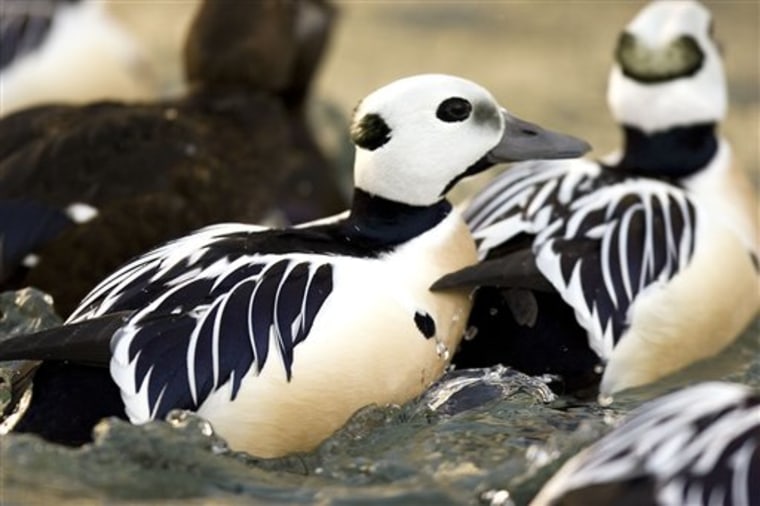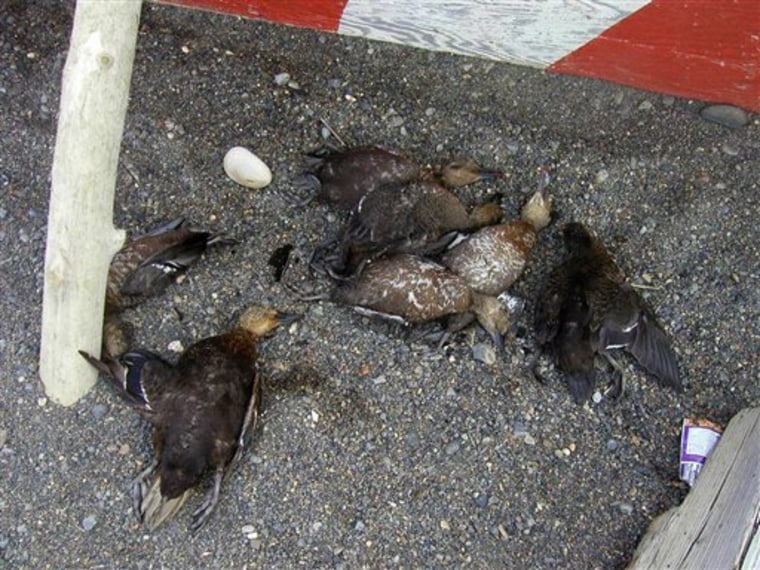A diminutive sea duck with a white head and a blue wing could bring restrictions to one of the last virtually unregulated hunting grounds in America.
Inupiat Eskimos on Alaska's northern coast for centuries have welcomed the spring return of waterfowl as a source of fresh meat after eight months of winter. They have been free to take almost whatever they want, whenever they want, without bag limits.
That could change this year. The U.S. Fish and Wildlife Services has proposed rules for subsistence hunting to protect Steller's eiders, a threatened species whose breeding numbers in the United States have dropped to an estimated 500 birds.
Steller's eiders are not sought by Inupiat hunters for meat, but they flock with the white-fronted geese, black brant and king and common eiders prized by hunters. Despite years of trying to educate hunters, federal officials found 27 dead Steller's eiders last year, including 20 that biologists confirmed had been shot. In one particularly disturbing discovery, a dead female Steller's eider was piled with carcasses of six juveniles outside a hunting blind.
Proposed rules would shorten hunting hours, ban shooting near roads, increase law enforcement presence, and set up a potential draconian measure: The agency's Alaska regional director could close all subsistence hunting to protect Steller's eiders.
The proposals are not sitting well with people who fought in court and Congress to retain rights to their land and the animals living on it.
"Part of subsistence is not just going out and killing your food. It's the freedom of going and getting the food from your land," said Barrett Ristroph, an attorney for the North Slope Borough. "Once someone comes in and says, 'You have to do this, you have to do that,' it kind of takes away what subsistence is all about."
Preserving species, and way of life
The dispute pits people trying to preserve a unique species against people equally passionate about preserving a way of life.
There are four species of eiders on the North Slope. Steller's are the smallest, averaging 17-18 inches long.
The sea ducks were once common on the Yukon-Kuskokwim Delta but breeding pairs for decades have not been seen anywhere except the Arctic Coastal Plain, with a concentration near Barrow, America's northernmost community. After breeding, Alaska birds and eastern Russia birds migrate to southwest Alaska.
Besides their distinctive plumage, Steller's eiders stand out for their breeding habits: They don't breed every year and appear to assess environmental conditions before deciding whether to lay eggs. Between 1992 and 2008, they nested in roughly half those years, said USFWS biologist Ted Swem, the endangered species branch chief for northern Alaska.

The new rules would set hunting hours to a half-hour before sunset until sundown — a seemingly silly requirement in the land of midnight sun, except that some Steller's eiders killed last year were shot in August, a month when the sun finally dips below the horizon. Sticking to daylight hours, federal officials hope, will allow hunters to distinguish between a Steller's eider and other birds.
The rules would also create a no-hunting buffer zone along roads outside Barrow: The buffer would have protected 91 percent of Steller's eiders nests documented in 2008.
Federal law enforcement could inspect hunters' bags for Steller's eiders and could fine them $400 plus $50 per bird.
Federal agents are sensitive to the resentment toward officers patrolling the hunting grounds. Both sides remember what happened nearly 50 years ago in a clash between western and indigenous interests.
A Washington official with the federal Bureau of Sport Fisheries and Wildlife decided to enforce provisions of a 1916 treaty with Canada that banned hunting from March through August and made no provision for subsistence hunting.
Federal game wardens in May 1961 arrested and confiscated the gun of a Barrow state representative, John Nusunginya, when he shot a couple of spring geese. A few days later, 138 hunters showed up with ducks in their hands at the warden's door and demanded to be arrested.
The Barrow "Duck-In" protest became a galvanizing moment for Alaska's indigenous people asserting their rights. They received national sympathy and federal officials eventually dropped charges and backed down from halting a hunt that had negligible effect on waterfowl populations.
Ristroph, the assistant North Slope Borough attorney, said the objections to the proposed rules start with the science behind them: Steller's eiders have always been a minor species on the North Slope and their numbers fluctuate up and down.
"As far as the eiders go, traditional knowledge indicates that there were never very many Steller's eiders on the North Slope," she said. And other factors could be to blame, like predators, pollution or climate change.
She said 56 percent of the households in Barrow get at least half their food through subsistence. Without it, they will have to travel farther or buy grocery store food, which would mean less healthful diets.
Stan Pruszenski, special agent in charge for the USFWS's Office of Law Enforcement, said the agency's attempts to phase in enforcement has been pushed forward by the circumstances of the Steller's eider.
"Oftentimes the regulations aren't viewed as necessary in that rural folks believe they have a history of self-regulation and they know how to conserve and protect wildlife," Pruszenski said. "In this particular instance, with eiders being threatened, the service is attempting to institute some additional conservation measures."
Swem said Steller's eiders in Russia are not considered threatened but losing the U.S. population would be significant.
"It's a fascinating bird with a unique and fascinating breeding ecology," he said. "To lose it as a breeding bird, to lose it as a member of the breeding avifauna of Alaska, to me would signal a loss. That would be a change for the worse."
